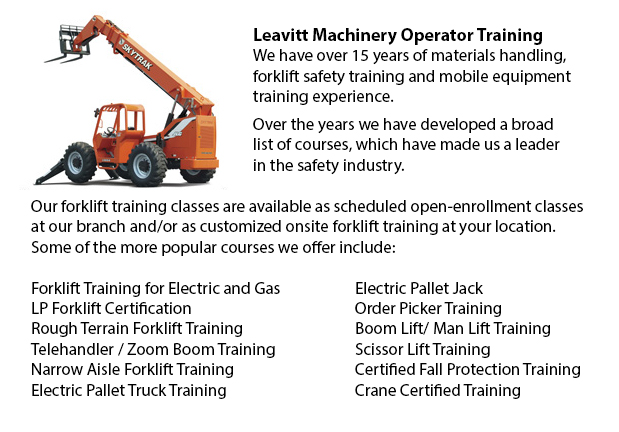
Telehandler Operator Training Fort Mcmurray - Telehandler forklifts or telescopic handler forklifts are usually seen on construction places and their popularity continues to increase. The versatility of telehandler forklifts makes sure that they are a valuable device needed on each work location. Telehandler Operator Training can be offered on our premises or at your work location.
A telehandler forklift is a kind of forklift designed along with a telescoping arm for lifting pallets or other things. These equipment are helpful in construction projects for lifting supplies to upper floors. They are also indispensable in big warehouse settings for accessing shelves that are really high. The telescoping arm is frequently powered by hydraulics. Vertical, smaller forklifts cannot reach the heights attainable by the telehandler forklift, that is what makes the telehandler very versatile. The telehandler forklift differs from other kinds of forklift in other ways; for instance, the telehandler models have pneumatic tires instead of solid rubber tires. Telehandler forklifts are similar in some respects to cranes, except that the telehandler cannot move its boom in various directions.
The forklift attachment on the telehandler allows the operator to unload and load pallets of things from the road or a truck, and moved to a higher surface like for example upper floors of a building. The telescoping arm provides great versatility as opposed to a standard forklift. The telehandler usually can move upward and downward, as well as forward and backward. The telehandler forklift can be equipped with various attachments.
The telescoping feature has inherent hazards because of stability issues when the load telescopes very far. That is why numerous models are outfitted along with outriggers that extend from the front of the vehicle to help with stability. Some models are available together with sensors which would shut down the power to the telescoping boom if the vehicle becomes unstable. It is vital for telehandler forklift operators to understand how to gauge whether load weight can be lifted to a given height in a safe manner. Manufacturer charts are utilized for this reason. The forklift size determines the wight load it can haul and the height at which it can operate. To prevent personal injury and machine damage, operators must be trained correctly in accident prevention.
-
Telehandler Training Fort Mcmurray
Telehandler Training Fort Mcmurray - Telehandlers or also called Telescopic handlers are very popular piece of heavy construction equipment most often utilized in agriculture and construction industries. These machines have extreme reaching capabilit... More -
Counterbalance Forklift Training Fort Mcmurray
Counterbalance Forklift Training Fort Mcmurray - Counterbalance Forklift Training courses are always in high demand. The Counterbalance forklift is a forklift that is made along with a weight that counters the balance, evenly spreading the weight of... More -
Heavy Equipment Training School Fort Mcmurray
Heavy Equipment Training School Fort Mcmurray - HEO or the heavy equipment operator courses will provide you with the knowledge and skills required in order to enter the workforce as an entry level heavy machine operator. In this 12 week course in ad... More -
Operator Safety Training, Re-Qualification Training, In-House Instructor Training in Fort McMurray
Used in just about all boat yards, industrial construction sites or warehouse operations, the forklift is a very important component in order to help pick up and transfer supplies. The reach feature of a lift truck could help improve the applications... More -
Heavy Equipment License Fort Mcmurray
Heavy Equipment License Fort Mcmurray - A heavy equipment license can be obtained by finishing a certification and preparation course at a private training school or a vocational school. This license would qualify you to operate various types of heav... More -
Boom Lift License Fort Mcmurray
Boom Lift License Fort Mcmurray - To operate an aerial boom lift, operators must be licensed through training that can be obtained utilizing both practical training and classroom sessions and by obtaining a boom lift license. Instruction must be give... More -
Skid Steer Loader Training in Fort McMurray
A skid-steer loader is actually an engine powered machine that consists of a small and rigid frame. It is outfitted along with lift arms which are used to attach to different labor saving attachments and tools. Normally, skid-steer loaders are four-w... More -
Order Picker Ticket Fort Mcmurray
Order Picker Ticket Fort Mcmurray - Order picker's enables warehouse employees to lift pallets using forks. Likewise called a stock picker, this electrically-powered equipment is like a forklift except that an order picker is likewise utilized to lif... More

Forklift Training Fort McMurray
TOLL FREE: 1-888-254-6157
Fort McMurray, Alberta
forklifttrainingfortmcmurray.com
Email Us
About Us


